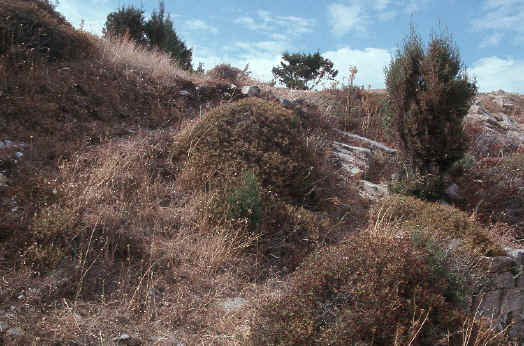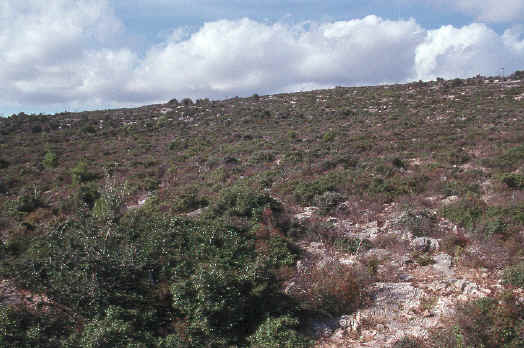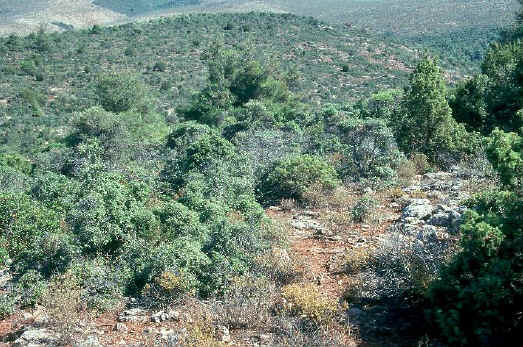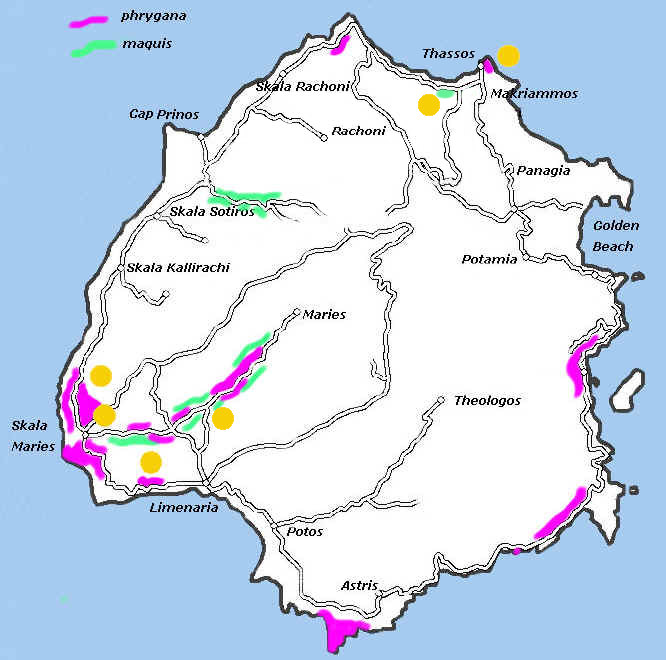______________________________________________________________________
LOWLAND SCRUB
One of the most characteristic habitats of the Mediterranean region is garigue,
a lowland vegetation community of dry soils, composed largely of spiny or
aromatic dwarf shrubs. In Greece these communities are known as phrygana and
there are several variants, depending upon grazing pressure, the incidence of
fires, exposure, soils and geology. In many respects they occupy the same
successional position as heathlands do elsewhere in Europe.
 Botanists
will probably recognise several forms of phrygana on Thásos, but generally
speaking the habitat can be classified into three main types. 'Eastern thorny
garigue' is a type of phrygana consisting of short, cushion-forming, spiny
aromatic shrubs on dry slopes. It is uncommon on Thásos and the only good
example I have seen is at Evariocastro, the headland to the east of Thassos Town
with the tiny chapel of Agion Apostolon. In early summer the small area around
the chapel is spangled with the flowering cushions of typical phrygana plants,
but this spectacle doesn't last long and drought and trampling reduce the
coastal slope to dusty bare ground by mid summer. Other examples probably exist
elsewhere on the island and I would be interested to hear of any information on
other localities.
Botanists
will probably recognise several forms of phrygana on Thásos, but generally
speaking the habitat can be classified into three main types. 'Eastern thorny
garigue' is a type of phrygana consisting of short, cushion-forming, spiny
aromatic shrubs on dry slopes. It is uncommon on Thásos and the only good
example I have seen is at Evariocastro, the headland to the east of Thassos Town
with the tiny chapel of Agion Apostolon. In early summer the small area around
the chapel is spangled with the flowering cushions of typical phrygana plants,
but this spectacle doesn't last long and drought and trampling reduce the
coastal slope to dusty bare ground by mid summer. Other examples probably exist
elsewhere on the island and I would be interested to hear of any information on
other localities.
Adjacent to this low coastal phrygana, freed from trampling and probably less
prone to drought, can be seen the second type of scrub community. 'Cistus
garigue' is frequent around much of the island's lowland zone
and is especially common in the northern half as an understorey in the conifer
woods and old olive groves. Pink cistus Cistus creticus is the most
abundant species but sage-leaved cistus C. salvifolius is also
widespread. Other species of this community include prickly juniper
Juniperus
oxycedrus, Phoenician juniper
Juniperus phoenicea, mock privet
Phillyrea
latifolia and Kermes oak Quercus coccifera. Good examples are
frequent in many locations around the island, such as the slopes north of Skala
Maries and along the south coast between Limenaria and Aliki. The southern
phrygana has extensive areas with tree heath Erica manipuliflora as a
dominant species and Spanish broom Spartium junceum is common.
coccifera. Good examples are
frequent in many locations around the island, such as the slopes north of Skala
Maries and along the south coast between Limenaria and Aliki. The southern
phrygana has extensive areas with tree heath Erica manipuliflora as a
dominant species and Spanish broom Spartium junceum is common.
The third form of phrygana, known as shiblyak, can be regarded as an
intermediate stage in the development to maquis. This is a taller scrub
community in which Kermes oak Quercus coccifera is usually common and
species such as Christ thorn Paliurus spina-christi, mastic tree Pistacia
lenticulus, Judas tree Cercis and chaste
tree Vitex agnus-castus frequently occur. This vegetation type is found
on abandoned terraces, neglected olive groves and undisturbed forest clearings
but it is quite localised and patchy in distribution.
Maquis is a tall shrub community that presumably represents a phase in
succession to secondary deciduous woodland. Pockets of maquis, composed of a
variety of species depending on the degree of shade, soil moisture and geology,
occur in many places around the island but some of the most extensive examples
can be found in the valley between Prinos and Megalo Kazavitis (where cornelian
cherry Cornus mas is a conspicuous component) and on the floodplain below
Maries (dominated by oriental plane Platanus orientalis). A small but
diverse example occurs amongst the conifers above the road at the western end of
the Thassos Town by-pass. Here mastic tree, strawberry tree Arbutus unedo, holm
oak Quercus ilex, Kermes oak and sallows Salix spp. grow amongst
sparse Calabrian pines Pinus
halepensis spp. brutia.
In general the lowland scrub habitats of Thásos are probably sufficiently
abundant not to be regarded as under immediate threat, although the eastern
thorny garigue is in poor condition if the example at Evariocastro is indeed its
only location on the island. Of late there does also seem to be a tendency to
reclaim neglected olive groves, often as a by-product of the construction of new
apartments, and hence shiblyak must also have considerably declined in extent.
Cistus garigue and maquis are common habitats on Thásos and the former is
currently extending its range as it colonises lowland slopes cleared of conifers
in the recent devastating summer fires.
Phrygana and maquis are widely distributed around the island, the map shows
conspicuous examples where there is good structural and/or botanical diversity.

